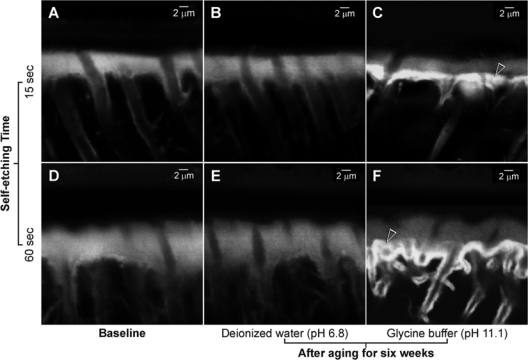Figure 1.

Confocal laser scanning microscopy images of Adper Prompt L-Pop-bonded dentin slabs. (A) A representative 15-second-etched baseline specimen before aging. Diffusion of the fluorescent dye into the permeable resin-bonded dentin subsurface resulted in the identification of a 5- to 6-µm-thick, palely fluorescent hybrid layer. (B) A representative specimen from the 15-second-etched, water-aged subgroup. The thickness of the hybrid layer was similar to that of the baseline specimen. (C) A 15-second-etched, glycine-buffer-aged specimen. Hybrid layer thickness was similar to that of the water-aged subgroup. Intense fluorescence could be identified from the base of the hybrid layer (open arrowhead). (D) A representative 60-second-etched baseline specimen before aging. A 10- to 12-µm-thick, palely fluorescent hybrid layer could be seen. (E) A 60-second-etched, water-aged specimen. Hybrid layer thickness was similar to that of the baseline specimen. (F) A 60-second-etched, glycine-buffer-aged specimen. Although the thickness of the hybrid layer was similar to that of the 60-second-etched, water-aged specimens, intense fluorescence could be identified from the basal area of the hybrid layer (open arrowhead). Collectively, there was no evidence to support that the self-etch adhesive etched continuously beyond hybrid layers during the period of prolonged water aging. However, increased fluorescence in the glycine-buffer-aged subgroups indicated that the base of those hybrid layers became more permeable after prolonged immersion in the alkaline glycine buffer.
